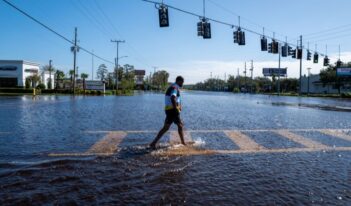
Achieving the green economy requires taking into account divisive politics and distributive justice.
In their recent article, Inequality, Social Resilience, and the Green Economy, Sidney Shapiro and Robert R. M. Verchick present a thoughtful progressive vision of environmental law.
Drawing on the notion of positive liberty and on Jedediah Purdy’s work on the origins of the environmental movement, Shapiro and Verchick argue that a “broadly shared source of motivation” for environmental law advocates initially included a deep concern for “social and economic wellbeing,” including “the fate of people losing their jobs.” They add that environmental lawmaking can achieve greater success if advocates return to this earlier vision by focusing on social resilience, which they define as “a population’s capacity to survive, adapt, and grow in the face of misfortune and change.” In particular, they maintain that environmental advocates can achieve this social resilience goal by increasing their focus on environmental justice concerns.
Shapiro and Verchick’s thesis is attractive for anyone who shares the authors’ concerns about both environmental protection and social justice, as I do. But doubling down on the progressive vision by focusing on social resilience in general, and environmental justice in particular, will not necessarily achieve Shapiro and Verchick’s progressive vision for environmental law. Three features of modern environmental law undermine the prediction that an increased focus on social resilience can create new momentum for environmental protection in the United States.
First, it is not clear whether Shapiro and Verchick’s strategy will involve simply returning to an earlier era of environmental advocacy. The notion that the environmental advocates of the 1950s and 1960s had a broad concern about jobs and other aspects of social welfare that they subsequently lost in the 1970s and 1980s—and thus that environmental advocates simply need to return to an earlier golden era—is an attractive idea. But it may simply be an idea that only fits squarely with what proponents of environmental justice hope to be true.
My own experiences with several 1960s-era environmental group leaders and early U.S. Environmental Protection Agency managers—albeit later in their careers—suggest that they were effective advocates who cared about broad conceptions of social welfare, but that they focused first and foremost on environmental issues. The progressive shift thus may be more novel and a heavier lift than the authors suggest.
Second, tying the environmental agenda more closely to a progressive social agenda is a risky strategy given the polarized state of politics in the United States. Adopting and sustaining new environmental laws and policies will require broad coalitions. Americans are broadly divided by party affiliation: 30 percent Democratic, 26 percent Republican, and 40 percent independent. The progressive social agenda will appeal to many Democrats but not to those Americans in the center and right of the political spectrum.
Recent work by sociologist Aaron McCright demonstrates the growing polarization between Democrats and Republicans on environmental legislation in Congress. Causal connections are hard to establish, but the emergence of this partisan gap after 1990 closely parallels the emergence of a period of gridlock on major federal pollution control legislation. In addition, the polarization in the general public on environmental issues is particularly acute for climate change. Polls taken over the last several years suggest that climate change is second only to health care as the most polarized issue.
The partisan divide on environmental and climate issues is not likely to evaporate anytime soon because it reflects deep differences in worldviews. Worldview differences can affect environmental policymaking in many ways, including by leading individuals to engage in solution aversion—that is, rejecting the existence of a problem such as climate change if they believe that it will require a response that they dislike. This phenomenon is a particular problem for the viability of a progressive environmental agenda because of widespread distrust of government solutions. Gallup surveys over the last decade show that between roughly two-thirds and three-quarters of the U.S. population believe that big government is the biggest problem facing the country.
Third, the conception of environmental justice that Shapiro and Verchick deploy in their social resilience analysis focuses on intra-generational justice—the effects of climate change and climate mitigation policies on the jobs, exposures to pollutants, and other quality-of-life factors of those living in this generation. This conception is the dominant approach to environmental justice in the legal literature, and it has been an adequate approach to environmental justice analysis for policies with costs and benefits that will arise largely in the near term.
But climate change presents a different problem. Much of the carbon dioxide emitted today will remain in the atmosphere 10,000 years from now. The harms arising from current emissions thus may occur for hundreds of generations. For instance, as the Intergovernmental Panel on Climate Change concluded in 2001, even if carbon emissions begin a steep decline in the next few decades, sea levels will still continue rising 1,000 years from now.
Distributive justice analyses should account for the intergenerational as well as intra-generational effects of climate change. This implication is hard to digest for those of us who care deeply about justice for those living today, but it is a near certainty that the descendants of people living in poverty today will suffer far more than the descendants of the wealthy. As a result, focusing only on the current generation will miss critical aspects of distributive justice and, if environmental justice concerns delay or weaken efforts to achieve major emissions reductions, this focus can even lead to unjust outcomes.
In short, Shapiro and Verchick present a thoughtful vision grounded in optimism about the political process. The remaining challenge is to develop a roadmap—and modify it, if necessary—to account for the dysfunctional political process in the United States and the intergenerational implications of the climate problem.
This essay is part of a six-part series, entitled Social Justice in a Green Economy.




